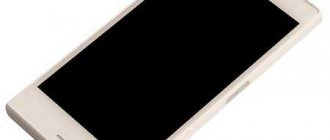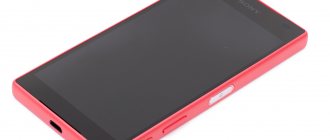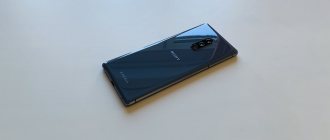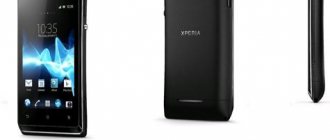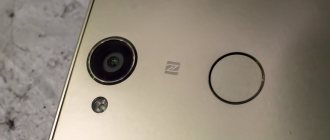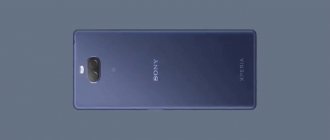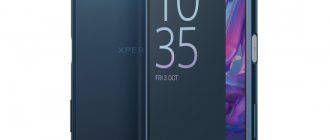I think Sony hardly needs to be introduced to anyone. The list of areas in which they are (or once were) leaders is impressive and extensive. For example, I have been using their NEX cameras for many years and am very pleased with them. Of course, Sony did not ignore a variety of audio equipment. Therefore, when I got my hands on the company’s top-end player and their hybrid headphones (no longer top-end, but not long ago they were), I didn’t deny myself the pleasure of giving them a good spin and sharing my opinion.
Since the player and headphones came to me for review without packaging, I will omit the part that describes the box and delivery kit; if you wish, you can easily find this information on the Internet, but I will tell you about everything else.
Sony ZX1 is practically a dying breed: it is a player based on Android OS. Moreover, if iBasso in their DX50 and DX90 Android is carefully hidden behind a custom shell, beyond which it is impossible to escape, then the ZX1 provides the user with an almost unchanged Android 4.1 interface. The company added a player widget, slightly changed the icons and wallpaper, almost everything else remained the same, including the ability to get root and break your player software. I don’t know why you need a full-fledged Android on the player, especially considering the fact that only the built-in player offers maximum quality (apparently, only for it Sony implemented direct access to the hardware), but I found one for myself (albeit a very nice plus) - DLNA support, allowing you to connect to my home Seagate NAS and listen to music from it via Wi-Fi. The player is timed to coincide with the 35th anniversary of the Walkman, so Sony put a lot of effort into its design and usability, which ultimately resulted in a hefty price tag that puts the ZX1 on the same level as top Chinese bricks. At the time of publication of the review, the player cost around 28,000 rubles.
Sony XBA-H3 is an ex-top hybrid model of in-ear headphones from the Japanese manufacturer, now they have been replaced by new models, so this is a good chance to grab the H3 at discounts on the secondary market or on sale. The price of new headphones at the time of publication of the review ranged from 10 to 12 thousand rubles. The headphones use Sony's own drivers, 16 mm dynamic for low frequencies, and two drivers with a balanced armature: one broadband, and the second responsible for high frequencies.
Specifications
Sony NWZ-ZX1
- Operating system: Android 4.1
- Audio formats supported: MP3, AAC, WMA, FLAC, WAV, DSD
- Equalizer: 5-band, there are sound enhancers
- Screen: 4″, TFT, FWVGA (854 x 480)
- Built-in memory: 128 GB, 114 GB user accessible
- Memory card support: no
- Full charge time: 3 hours
- Operating time on one charge (listening to music): up to 32 hours
- Connectors: WM-PORT, 3.5 mm TRS headphone output
- Dimensions: 59.7mm x 122.3mm x 13.5mm
- Weight: 139 g
Sony XBA-H3
- Frequency range: 3 Hz – 40 KHz
- Impedance: ≈ 40Ω @ 1KHz
- Sensitivity: 107 dB/mW
- Emitters: dynamic, 16 mm, two reinforcement
- Cable: replaceable, 1.2 m, standard and with headset included, Litz, oxygen-free copper
- Cable Connectors: MMCX
- Weight: 10 g
(SEL-2470GM)
Lens from the professional reportage troika. An all-rounder with tasks ranging from landscape painting to sports reporting. 13 optical elements in 18 groups, where one element is made of ultra-low dispersion glass, one lens is made of low dispersion glass, two elements are aspherical and one more is a Sony XA lens, an aspherical ultra-low dispersion with ultra-close tolerances. 9 rounded aperture blades. The DDSSM focusing motor controls the floating optical element. The minimum focusing distance is 0.38 m. Manual subfocus is available at any time. Diameter for filter 82 mm. Dimensions 136x88 mm, weight 886 g. The body has a programmable focus lock button, autofocus switch and focus ring lock.
Design
Sony's player turned out to be a feast for the eyes; the hand of the company's designers is immediately felt. Silver aluminum, black screen glass, leather-like back panel, everything gives the impression of an expensive and stylish product. Everything has been thought out, including the click when pressing the side buttons. The designers even took care of balancing the weight of the player, which allows you to comfortably hold the ZX1 with one hand.
On the right panel there are buttons for controlling playback, volume and power. At the bottom there is a WM port and a headphone jack. I don’t know why Sony didn’t use a standard MicroUSB connector, but large companies have their own special vision of design. This same vision, apparently, made the 3.5 mm jack so strange. On the rear panel there is a speaker stylized as a Walkman logo; its volume is average; it is not suitable for those who like to listen to music on the street (although those who like to listen to music through a speaker on the street can buy the ZX1 only by selling a kidney).
The player's screen does not reach the top solutions used in modern smartphones, but for a player it is more than good. Viewing angles are normal, color rendition is pleasing. Persons prone to masochism can watch movies on the player screen without any problems.
With headphones, ergonomics are much worse. Sony didn't come up with anything better than placing the dynamic emitter vertically, perpendicular to the plane of the ears. This has led to the fact that the headphones protrude very far to the sides; wearing them, for example, with a hat is unrealistic. The headphones are intended to be used only with the wire oriented behind the ear; due to their size and weight, wearing them with the wire down is not very possible. The wires near the connector have areas with a memory effect; they can be used to form earhooks, this helps to properly seat the headphones. I immediately advise you to use the included eartips with foam filling inside (Sony Hybrids), they improve the fixation of the headphones in the ears and provide reliable isolation of the channel, which is necessary for the bass to remain impactful and clear.
Despite the first impression, if you get used to it, wearing the Sony XBA-H3 is quite easy, since the entire earphone is located outside, and only the sound guide needs to be placed in the ears; these hybrids are suitable for almost any ears. The correct selection of attachments allows you to wear them indefinitely.
The well-thought-out design of the flat cable makes it very convenient: it gets tangled less and the microphone effect is almost absent. The connectors are reliable and hold the cable well.
Sound insulation is at an average level.
SONY LENSES: OPTICAL TECHNOLOGY EXAMINATION
Not long ago, we introduced our readers to the professional line of Sony G Master lenses and told us why these glasses can rightfully be called the pinnacle of engineering excellence. “Russian Photo” continues to explore Sony optics together with users: we look at the rest of the company’s lenses and select those that fit the budget and needs.
Right now there are 82 lens models for sale on the Sony website. How to understand what exactly to choose among such a variety? Let’s be clear right away: in this article we will consider lenses for the E-mount mount, since the most popular today are the legendary full-frame mirrorless Sony A7 series and APS-C cameras of the A6XXX line. Let’s remove the G Master line from the search, put a filter at a price of up to 100 thousand rubles and get about 30 lens models. For convenience, we will divide them into groups according to purpose: portrait, video, telephoto, universal zoom and wide angle. We will place from 3 to 5 models in each group.
Historical and technical educational program
Sony optics are prized for their amazing image sharpness and contrast. For more than 20 years, the company has maintained a partnership with the German company Carl Zeiss, a world leader in the field of photo-optics. The Carl Zeiss company has been developing precision optical solutions for 173 years and has dozens of patents.
The first joint product between Sony and Zeiss was the Handycam® CCD-TR555 camcorder, released in 1996. Further developments were concentrated in the field of interchangeable optics - in 2006, the first lens for Sony DSLR cameras with an A-mount appeared. 5 years later, in 2011, the first lens models for the new E-mount were released.
“Sony's many years of high-tech experience and access to the end consumer combine perfectly with Zeiss' optical developments. Together we have become a very strong team,” says Dr. Winfried Scherle, Head of Consumer Optics Development at Zeiss.
Zeiss/Sony lenses are distinguished by good aperture, sharp and contrasting patterns, as well as premium performance - all of them are housed in a strict aluminum body with a minimalist design. Silent and fast autofocus, a special patented anti-reflective coating, compatibility with full-frame and APS-C matrices and, of course, the famous logo, where the treasured Zeiss is written in white and blue.
In addition to Zeiss and G Master, Sony has a line of budget lenses for crop and full frame. Such lenses do not have a special name, but have format designations: FE - full-frame optics, E - lenses for APS-C matrices.
Additionally, Sony has a line of G series lenses, a professional glass line that has set the bar for quality in the industry for many years. Recently, it has been complemented by an even more technologically advanced G Master series.
PORTRAIT
For shooting portraits, primes are often used - lenses with a fixed focal length. This way you can achieve the best sharpness and contrast, as well as beautiful and smooth bokeh.
FE 85 mm F1.8
(SEL85F18)
An affordable “portrait lens” with impressive characteristics: the lens combines compactness and lightness with high-quality optics and a large aperture of F1.8. The lens weighs just 371 grams and features dual linear motors for fast, accurate and quiet focusing. Low dispersion glass and a 9-blade diaphragm provide smooth bokeh and the famous “Sonevsky” sharpness.
Sonnar T* FE 35 mm F2.8 ZA (SEL35F28Z)
The next discrete camera in the category is the Carl Zeiss Sonnar with an F2.8 aperture and a universal focal length of 35 millimeters. A feature of the entire Zeiss line is high contrast and good resolution across the entire frame area. In addition, each lens released in the series is adjusted manually. The letter T in the model name denotes a special coating necessary to reduce the amount of light and glare. The lens has fast and silent autofocus. The full potential of the glass is revealed when used with the new Sony A6400 or A9, whose focusing speed reaches 0.02 and 0.05 seconds respectively!
Sonnar T* FE 55 mm F1.8 ZA (SEL55F18Z)
Another representative of the Zeiss family is a 55mm portrait lens with an F1.8 aperture. A focal length of 50+ millimeters is closest to how the human eye perceives an image - a universal solution for portraiture and street photography. A 9-blade diaphragm produces smooth bokeh, and the dust and moisture protection allows the lens to be used in different weather conditions. In addition, the lens is very small and light - only 281 grams. In terms of dimensions, it is comparable to the legendary Helios 44-2. Like the previous model, the FE 55 mm F1.8 ZA works perfectly in tandem with full-frame A7 series cameras, as well as compact crop cameras A6400/A6500: all autofocus capabilities are available, and the dimensions allow you to fit the entire set into a small photo bag.
| SPECIFICATIONS | |||
| LENS | FE 85mm F1.8 | Sonnar T* FE 35 mm F2.8 ZA | Sonnar T* FE 55 mm F1.8 ZA |
| Bayonet | Sony E | Sony E | Sony E |
| Format | Full frame, 35mm | Full frame, 35mm | Full frame, 35mm |
| Focal length | 85mm | 35mm | 55mm |
| Maximum aperture value (F) | 1.8 | 2.8 | F1.8 |
| Minimum aperture value | 22 | 22 | 22 |
| Viewing Angle (35mm / APS-C) | 29゚/ 19゚ | 63゚/ 44′ | 43° / 29′ |
| Equivalent focal length for 35MM (on APS-C sensors) | 127.5mm | 52.5mm | 82.5mm |
| Aperture blades | 9 | 7 | 9 |
| Circular aperture | Yes | Yes | Yes |
| Minimum focusing distance | 0.8 meters | 0.35 meters | 0.5 meters |
| Maximum magnification factor (X) | 0,13 | 0,12 | 0,14 |
| Filter diameter | 67mm | 49mm | 49mm |
| Image stabilization (SteadyShot) | — (integrated with camera) | — (integrated with camera) | — (integrated with camera) |
| Groups / elements | 8/9 | 5/7 | 5/7 |
VIDEO
Today, Sony mirrorless cameras are actively used by videographers. Advertising, music videos, TV and YouTube projects - everything is shot by “alphas”. Needless to say, Sony engineers are well versed in the film industry. For example, since 1999 there has been a line of professional film optics CineAlta. The main criteria when choosing lenses for video shooting are a stabilizer, a smooth focusing ring and good aperture. All modern Sony E-mount optics are designed for photo and video shooting. All models have silent and fast autofocus and a smooth zoom ring. The following three models are designed specifically for use in video production.
E PZ 18-200 mm F3.5-6.3 OSS
SELP18200
A crop lens for video shooting with a motorized zoom is an ideal solution for smooth control of focal lengths while recording a video. The glass is also equipped with an Optical Steady Shot stabilizer and a 7-blade diaphragm for more natural defocusing. The wide range of focal lengths will make the lens a versatile tool in every videographer's arsenal.
FE PZ 28-135 mm F4 G OSS
SELP28135
A professional cinema lens for serious filming. The lens is suitable for full-frame cameras that shoot high-resolution video. Precision optical design with support for 4K and future formats and minimal change in angle of view during focusing are borrowed from professional Sony equipment. Three manual control rings fully meet the demands of professional wide-format shooting, and the SSM drive, implemented for the first time in a video lens, ensures quiet operation of a motorized zoom.
E PZ 18–110mm f/4 G OSS
SELP18110G
The most advanced cine lens available in E-mount, the 18-110mm zoom covers the range most commonly used in Super 35/APS-C video shooting at a constant f/4 aperture. The G Lens delivers the wide-area image quality needed for 4K video production. Sony's SMO (Smooth Optical Optics) technology minimizes image shift due to optics, while extensive zoom control and precise focusing allow you to realize any director's vision.
SPECIFICATIONS | ||||
| LENS | E PZ 18-200 mm F3.5-6.3 OSS | FE PZ 28-135 mm F4 G OSS | E PZ 18–110mm f/4 G OSS | |
| Bayonet | Sony E | Sony E | Sony E | |
| Format | APS-C | Full frame, 35mm | APS-C | |
| Focal length | 18-200 | 28–135 mm | 18–110 | |
| Maximum aperture value (F) | 3.5 | 4 | 4 | |
| Minimum aperture value | 22-40 | 22 | 22 | |
| Viewing Angle (35mm / APS-C) | 76°-8° | 63゚/ 44′ | 76°—14°30′ | |
| Equivalent focal length for 35MM (on APS-C sensors) | 27–300 mm | 42–202.5 mm | 27–165 | |
| Aperture blades | 7 | 9 | 7 | |
| Circular aperture | Yes | Yes | Yes | |
| Minimum focusing distance | 0.3 meters | 0.4 meters / 0.95 m (tele position) | 0.4 m (wide angle) - 0.95 m (tele position) | |
| Maximum magnification factor (X) | 0,13 | 0,15 | 0,122 | |
| Filter diameter | — | — | — | |
| Image stabilization (SteadyShot) | Optical SteadyShot Stabilizer | Optical SteadyShot Stabilizer | Optical SteadyShot Stabilizer | |
| Groups/elements | 12/17 | 12/18 | 15–18 | |
TELEPHOTOS
In this group, Sony lenses offer a wide range of distances - from 55 to 300 millimeters - while maintaining sufficient aperture.
E 55–210 mm, F4.5–6.3 OSS (SEL55210)
3.8x zoom with low weight - 315 grams. The built-in stabilizer helps you get sharp, blur-free photos even at the long end. The minimum focusing distance is 1 meter. On APS-C matrices, the PR range will be 82–315 millimeters. The lens will pleasantly please you with its price and performance - for 26,000 rubles we get an aluminum alloy body and wide focus and zoom rings. The optics are designed for APS-C matrices, but will also work on full-frame cameras if necessary.
FE 24–240 mm F3.5—6.3 OSS (SEL24240)
The second in the telephoto group was a 24-240 mm zoom with an optical stabilizer - an excellent solution for all occasions. The magnification factor is 10×, which allows you to photograph nature, animals, and architecture. This type of zoom should be an integral part of a photographer's arsenal when traveling. Improved optics effectively suppress aberrations, creating an image without loss of detail across the entire frame area; Precision linear drive ensures fast, smooth focusing. Handheld telephoto photography in low-light conditions is no problem - the lens is equipped with OSS optical stabilizer.
FE 70–300 mm F4.5—5.6 G OSS (SEL70300G)
For the latest model in this category, we will make an exception - the FE 70–300 mm F4.5-5.6 G OSS telephoto camera represents the G series. The minimum focusing distance is 0.9 meters. High-resolution images are obtained at any focal length - the lens has four aspherical lenses and two low-dispersion (ED) glass elements, which are treated with Sony's Nano AR anti-reflective coating. Focal lengths of 70–300 millimeters are convenient for shooting sports and reporting. Also, such lenses are often used for portrait photography. With APS-C cameras, a focal length of 300 millimeters is equivalent to a super-telephoto of 450 millimeters. We also note the programmable focus lock button - one of Sony's features.
| SPECIFICATIONS | |||
| LENS | E 55-210 mm, F4.5-6.3 OSS | FE 24-240 mm F3.5-6.3 OSS | FE 70-300mm F4.5-5.6 G OSS |
| Bayonet | Sony E | Sony E | Sony E |
| Format | APS-C | Full frame, 35mm | Full frame, 35mm |
| Focal length | 55-200mm | 24-240mm | 70-300mm |
| Maximum aperture value (F) | F4.5-6.3 | 3.5-6.3 | F4.5-5.6 |
| Minimum aperture value | 22-32 | 22-40 | 22-29 |
| Viewing Angle (35mm / APS-C) | 29 - 7 (APS-C) | 84°- 10° / 61 — 6 | 34’-8’ / 23’ — 5’ |
| Equivalent focal length for 35MM (on APS-C sensors) | 82.5-315mm | 36-360mm | 105-450mm |
UNIVERSAL ZOOM
Lenses in this category offer a wide range of focal lengths while maintaining excellent optical properties.
E 18–200 mm F/3.5—6.3 OSS LE (SEL18200LE)
Versatile zoom with the widest range of focal lengths. The LE prefix stands for Lightweight E - a lightweight model designed for APS-C matrices. The 11x zoom is paired with OSS optical stabilizer. The internal focusing mechanism is silent and the lens barrel remains static. The minimum focusing distance is 0.5 meters. Weighing 460 grams, the model can easily be taken with you on trips or on location shooting.
Vario-Tessar T* E 16–70 mm F4 ZA OSS (SEL1670Z)
Another lens for APS-C matrices. This zoom lens features a lightweight design and combines the performance of Zeiss optics with the constant aperture of the F4 for precision performance at all focal lengths. The linear motor drive provides smooth, quiet operation and responsive autofocus, making this lens ideal for video and photography in a variety of situations. There is a built-in Optical SteadyShot stabilizer. Focal lengths of 16–70 millimeters will be optimal for both architectural photography and portraits.
FE 28–70 mm F3.5—5.6 OSS (SEL2870)
Standard lens for the first generation Sony A7. The focal length range of 28–70 millimeters is one of the most popular among photographers and videographers. Built-in Optical SteadyShot (OSS) helps reduce shake when shooting handheld. Paired with the matrix stabilizer in the Sony A7 III, the picture turns out to be really smooth even while walking. When shooting close-ups, you can beautifully blur the background thanks to the 7-blade rounded aperture.
FE 24–105 mm F4 G OSS (SEL24105G)
An absolutely universal lens that is in the lineup of every manufacturer. 24–105 millimeters is the optimal distance for portrait or reportage photography and video recording. Constant aperture F4. The front element of the lens has a fluorine coating that protects it from dirt and moisture. If necessary, residual water or oil can be easily wiped off the surface. A customizable focus hold button and a water- and dust-resistant design ensure reliable operation in any environment. In addition, owners of the FE 24–105 mm have access to a macro mode - the minimum focusing distance is 0.38 meters.
DT 18–135 mm F3.5–5.6 SAM
SEL18135
A crop lens with a very wide range of focal lengths. This lens is great for travel and outdoor photography. The Smooth Autofocus Drive (SAM) built into the lens is smoother and quieter than conventional camera-coupled AF drive systems. Switching to manual focus mode is done by turning the ring on the lens. In addition, the lens has a minimum focusing distance of 0.45 meters, which allows you to take pictures close to marko images.
| SPECIFICATIONS | |||
| LENS | E 18–200mm f/3.5—6.3 OSS LE | Vario-Tessar T* E 16-70 mm F4 ZA OSS | FE 24–105 mm F4 G OSS |
| Bayonet | Sony E | Sony E | Sony E |
| Format | APS-C | APS-C | Full frame, 35mm |
| Focal length | 18-200mm | 16-70mm | 24-105mm |
| Maximum aperture value (F) | 3.5–6.3 | F4 | F4 |
| Minimum aperture value | 22-40 | 22 | 22 |
| Viewing Angle (35mm / APS-C) | 76°—8 (APS-C) | 82°—23 (APS-C) | 84° — 23’ / 61’-15’ |
| Equivalent focal length for 35MM (on APS-C sensors) | 27—300mm | 24—105mm | 36-157mm |
| Aperture blades | 7 | 7 | 9 |
| Circular aperture | Yes | Yes | Yes |
| Minimum focusing distance | 0.5 meters | 0.35 meters | 0.38 meters |
| Maximum magnification factor (X) | 0,27 | 0,23 | 0,31 |
| Filter diameter | 62mm | 55mm | 77mm |
| Image stabilization (SteadyShot) | Optical SteadyShot Stabilizer | Optical SteadyShot Stabilizer | Optical SteadyShot Stabilizer |
| Groups / elements | 13/17 | 12/16 | 14/17 |
| SPECIFICATIONS | |||
| LENS | DT 18–135 mm F3.5–5.6 SAM | FE 28-70mm F3.5-5.6 OSS | |
| Bayonet | Sony E | Sony E | |
| Format | APS-C | Full frame, 35mm | |
| Focal length | 18-135 | 28-70mm | |
| Maximum aperture value (F) | 3.5-5.6 | F3.5-5.6 | |
| Minimum aperture value | 22-36 | 22-36 | |
| Viewing Angle (35mm / APS-C) | 76°—12° | 75゚—34゚/ 54°—23° | |
| Equivalent focal length for 35MM (on APS-C sensors) | 27–202.5 mm | 42-105mm | |
| Aperture blades | 7 | 7 | |
| Circular aperture | Yes | Yes | |
| Minimum focusing distance | 0.45 m | 0.3-0.45 meters | |
| Maximum magnification factor (X) | 0.25x | 0,19 | |
| Filter diameter | 62 mm | 55mm | |
| Image stabilization (SteadyShot) | — | Optical SteadyShot Stabilizer | |
| Groups/elements | 11/14 | 8/9 | |
WIDE ANGLE
FE 12–24 mm F4 G (SEL1224G)
Another representative of the Sony G line is a full-frame lens with an F/4 aperture at all focal lengths. The FE 12–24 mm F4 G has the widest angle of any full-frame lens from Sony. The quiet autofocus mechanism will be useful when shooting video. Features include a customizable focus hold button, as well as dust and moisture protection.
E 10–18 mm F4 OSS (SEL1018)
Lens designed for use with APS-C matrices. Ultra-wide angles from 10 to 18 millimeters allow you to shoot interiors even in small spaces. A constant F/4 aperture will provide enough light to take quality photos. The 7-blade rounded diaphragm creates a soft bokeh effect. In addition, the lens is equipped with optical image stabilization and a fast autofocus drive.
E 20 mm F2.8 (SEL20F28)
Compact discrete “pancake” with a wide angle of 20.4 millimeters, designed specifically for APS-C matrices. Aspherical lens elements reduce distortion and aberration. A good aperture will allow you to get “silent” pictures even in poor lighting.
Vario-Tessar T* FE 16–35 mm F4 ZA OSS (SEL1635Z)
The Zeiss Vario-Tessar 16–35 mm wide-angle zoom with improved aspherical lenses will be useful when shooting indoors or outdoors. On APS-C matrices the focal length will be 24–52 millimeters. A constant aperture value will allow you to easily change the focal length while shooting video without having to change the exposure settings. Of course, there is a built-in OSS stabilizer, as well as smooth and fast focusing. Another feature of the Zeiss line is the silent linear drive, which is extremely important when recording audio to video.
Sonnar T* E 24 mm F1.8 ZA (SEL24F18Z)
Wide-angle prime lens in a solid aluminum body with a wide and smooth focusing ring. The focal length of 24 millimeters is one of the “gold standards” in photography and cinema - such lenses are good for taking general and medium plans. The F1.8 aperture will create decent bokeh. In addition, the minimum focusing distance is only 16 millimeters - we get macro shots at a scale of 1:4 with good detail and an interesting wide-angle perspective. Also, with a thread diameter of 49 millimeters, a large fleet of light filters immediately becomes available to the user. The optics are made for APS-C.
| SPECIFICATIONS | |||
| LENS | FE 12-24mm F4 G | E 10-18 mm F4 OSS | E 20 mm F2.8 |
| Bayonet | Sony E | Sony E | Sony E |
| Format | Full frame, 35mm | APS-C | APS-C |
| Focal length | 12-24mm | 10-18mm | 24mm |
| Maximum aperture value (F) | F4 | 2.8 | 2.8 |
| Minimum aperture value | 22 | 22 | 22 |
| Viewing Angle (35mm / APS-C) | 122′ — 84 / 99 — 61’ | 109' — 76° (APS-C) | 70' (APS-C) |
| Equivalent focal length for 35MM (on APS-C sensors) | 18-36mm | 15-27mm | 30mm |
| Aperture blades | 7 | 7 | 7 |
| Circular aperture | Yes | Yes | Yes |
| Minimum focusing distance | 0.28 meters | 0.25 meters | 0.2 meters |
| Maximum magnification factor (X) | 0,14 | 0,1 | 0,12 |
| Filter diameter | Not provided | 62mm | 49mm |
| Image stabilization (SteadyShot) | — (integrated with camera) | Optical SteadyShot Stabilizer | — (integrated with camera) |
| Groups / elements | 13/17 | 8/10 | 6/6 |
| SPECIFICATIONS | |||
| LENS | Vario-Tessar T* FE 16-35 mm F4 ZA OSS | Sonnar T* E 24 mm F1.8 ZA | |
| Bayonet | Sony E | Sony E | |
| Format | Full frame, 35mm | APS-C | |
| Focal length | 16-35mm | 24mm | |
| Maximum aperture value (F) | F4 | F1.8 | |
| Minimum aperture value | 22 | 22 | |
| Viewing Angle (35mm / APS-C) | 107′ — 63 / 83 — 44′ | 61° (APS-C) | |
| Equivalent focal length for 35MM (on APS-C sensors) | 24-52.5mm | 36mm | |
| Aperture blades | 7 | 7 | |
| Circular aperture | Yes | Yes | |
| Minimum focusing distance | 0.28 meters | 0.16 meters | |
| Maximum magnification factor (X) | 0,19 | 0,25 | |
| Filter diameter | 72mm | 49mm | |
| Image stabilization (SteadyShot) | Optical SteadyShot Stabilizer | — (integrated with camera) | |
| Groups/elements | 10/12 | 7/8 | |
Today, Sony has one of the most advanced lines of lenses - everyone can choose a model for certain tasks - you can choose a photo or video lens from the focal length range of 12-800 millimeters (with a teleconverter). On the Sony Russia website there is a convenient search for all models of lenses with filters by characteristics, price, and line.
Sound
The following headphones were used to listen to the player:
- Ambient Acoustics AM6 HiRez
- HiFiMan Re600
- VSonic Gr01
and VSD3S - Philips Fidelio X1
- Dunu DN-2000
The first thing that can be said is that with the ZX1 you should immediately forget about almost any tight on-ear headphones; it simply does not have enough power to fully open even medium-tight models.
Moreover, the volume usually remains even with a reserve, detailing and especially bass control are subject to degradation. The situation improves greatly when using sensitive IEMs. The player demonstrates good resolution and microdynamics. The sound is quite smooth and neutral. The main key to obtaining maximum sound quality is to turn off all the built-in “improvers”; instructions on how to do this are available on the Internet; any attempt to use all these CLEAR STEREO and other DYNAMIC NORMALIZER leads to a noticeable deterioration in the sound.
There is enough bass in quantity, it is well controlled, and, although it is inferior to top-end players in terms of attack speed, it will still satisfy most listeners. The mids are clean, there is no artificiality, and the separation of instruments is at a good level. The high frequencies are a little simplified, but are presented without intrusiveness, which leads to a pleasant, non-tiring sound of the player.
The following equipment was used for listening:
- Resonessense Labs Concero HP as a DAC and headphone amplifier
- Apple MacBook Pro Retina 2013 as a source
- Audirvana Plus 2.0.2 as a player
- HiFiMan 901 and Fiio X5 as portable players
- VSonic Gr01 and HiFiMan Re600 as headphones for comparison
- High-resolution recordings in Lossless formats (Dr. Chesky The Ultimate Headphone Demonstration Disc and others)
Despite the ergonomic problems, the Sony hybrids were a success in terms of sound. Reading about the 16 mm driver, I expected incredible infernal bass from them, but in this case I was pleasantly deceived. The H3 does not have the V-shaped frequency response typical of other hybrids with a rise in low and high frequencies; the engineers who tuned the crossover did their best.
The bass is slightly raised relative to the midrange, but not much. In general, the frequency response of these hybrids surprises with its evenness. Despite this, the dynamic driver does exactly what is expected of it - it plays out the bass, giving it amazing density and depth. The bass is simply felt physically, giving exactly the effect for which hybrid headphones are loved.
Mids are smooth and very detailed. Even with the most top-end sources, the XBA-H3 is able to convey the maximum information included in the recording.
The high frequencies are also very good, they are enough to convey the smallest nuances of music, but thanks to successful tuning, there is no harshness and fatigue, even on low-level sources.
Of course, I can't help but say a little about the combination of the NWZ-ZX1 with the XBA-H3. They play well together (it would be surprising if Sony did it differently), giving a very unusual sound. I would call it festive, somewhat reminiscent of the signature sound of Audio-Technica headphones. The pairing seems to show you: here are very deep low frequencies, going almost into the infrabass, and here is an interesting solo on an acoustic guitar, there is a violin, the sound of which dissolves in space. This sound is discouraging at first, sometimes the music gets lost behind all sorts of “interesting things,” so this combination will either immediately appeal to you, or will make you want to change something. It certainly won’t leave anyone indifferent, but I wouldn’t recommend taking it without listening to it.
New FE 85mm F1.4 GM telephoto lens
Designed as the ultimate portrait lens, the highly anticipated new FE 85mm F1.4 GM telephoto prime lens (Model SEL85F14GM) strikes the perfect balance between resolution and bokeh in a compact body.
This lens features a new XA (extreme aspherical) element, as well as three ED glass elements that work together to ensure that the in-focus area is captured with extreme sharpness while the surrounding out-of-focus areas of the frame fade away to create a beautifully soft background. It features an 11-blade circular diaphragm—the highest number of blades ever used in a lens—that ensures smooth, attractive bokeh effects. On the outside, the new model features Sony's proprietary Nano AR coating, which is especially important for portrait lenses as it reduces flare and ghosting even when the subject is against a brightly lit background, backlit or similar challenging lighting conditions.
For precise autofocus, the FE 85mm F1.4 GM lens is equipped with a ring-type SSM focus drive, which provides enough power and speed to move a large, heavy focal group of lens elements. It also features dual position sensors to ensure perfect control of large and heavy lens elements during focusing.
This new professional portrait lens is dust and moisture resistant and features an aperture control ring with on/off step adjustment that can be adjusted depending on whether you're shooting photos or videos. There is also a manual/automatic AF/MF switch and a focus lock button.
Specifications Sony 85mm F1.4 GM
| Principal specifications | |
| Lens type | Prime lens |
| Max Format size | 35mm FF |
| Focal length | 85 mm |
| Image stabilization | No |
| Lens mount | Sony FE |
| Aperture | |
| Maximum aperture | F1.4 |
| Minimum aperture | F16.0 |
| Aperture ring | Yes |
| Number of diaphragm blades | 11 |
| Optics | |
| Elements | 11 |
| Groups | 8 |
| Special elements/coatings | Extreme Aspherical, Super ED, ED elements + Nano AR coating |
| Focus | |
| Minimum focus | 0.80 m (31.5″) |
| Maximum magnification | 0.12× |
| Autofocus | Yes |
| Motor type | Ring-type ultrasonic |
| Full time manual | Yes |
| Focus method | Internal |
| Distance scale | No |
| DoF scale | No |
| Focus distance limiter | No |
| Physical | |
| Weight | 820 g (1.81 lb) |
| Diameter | 90 mm (3.52″) |
| Length | 108 mm (4.23″) |
| Sealing | Yes |
| Color | Black |
| Filter thread | 77.0mm |
| Hood supplied | Yes |
| Hood product code | ALC-SH142 |
Compatibility
I already wrote above about the player’s compatibility with different headphones, so I won’t repeat it.
As for the XBA-H3, I can only mentally take off my hat to the Sony engineers. The headphones turned out to be surprisingly versatile and not capricious. It is quite possible to listen to them not only with simple players, but also with smartphones (with the exception, perhaps, of the cheapest ones), and the headphones also do not give up with top sources.
Sony Xperia XZ1 review: screen
The Xperia XZ1 screen is inferior to the Xperia XZ Premium not only in diagonal size (5.2 inches versus 5.46 inches), but also in resolution (1920x1080 pixels versus 3840x2160 pixels). Accordingly, the pixel density per inch dropped from a record 807 ppi by almost half (to 424 ppi). But support for HDR technology remains. The easiest way to see what HDR content looks like on such a screen is on YouTube. For the display, proprietary technologies have also been used - Triluminos, Dynamic Contrast Enhancement and X-Realty for mobile.
The screen on the Xperia XZ1 is very bright. The comfortable backlight level is selected either manually or automatically (“Adaptive adjustment”). Changing the color temperature of the screen (“White Balance”) makes the shades warmer or, conversely, cooler. The option of the same name in the “Screen” section helps you use your smartphone with gloves. The backlight control function automatically detects whether the device is in your hand or not. In the first case, the screen does not go dark, but in the second it turns off in accordance with the timeout setting.
AnTuTu Tester was able to recognize up to ten simultaneous touches. Three color profiles (“Professional”, “Standard” and “Ultimate Brightness Mode”) allow you to choose between spectacular, rich colors and calmer, natural shades. Judging by the passport data, the screen color gamut is 138% sRGB. But a clear and natural image when playing video is assigned to the X-Reality for mobile option. The Corning Gorilla Glass 5 protective glass has a high-quality oleophobic coating.
conclusions
NWZ-ZX1 remained a little unclear for me. I don't quite understand his target audience. For ordinary music lovers it is too expensive, for spoiled audiophiles its sound is too simple; for comparable money you can buy a player that sounds noticeably better (although, of course, it looks much worse). Fans of the Sony brand, of course, have already endowed it with incredible sound in their reviews, comparable to the best examples of audio equipment, but this is not so. The sound of the ZX1 is, of course, good, but it doesn’t reach “excellent”. If the player cost around $400, it would be a very good deal, but at $680, it's not very competitive. Sony recently announced new, more budget models with support for high-resolution audio, I think they will be more interesting in terms of price/quality ratio.
XBA-H3, in turn, was a success for the company. More linear than most hybrids, the frequency response makes them genre-independent, while the punchy bass and excellent resolution across the entire range show why hybrid technology was chosen. Despite the controversial ergonomics, the headphones are very, very good, and the upcoming price reduction makes them a very interesting purchase.
(SEL-100400GM)
Professional long-focus zoom for event, sports reporting and landscape tasks. 16 optical elements in 22 groups, where one element is made of ultra-low dispersion glass, two low dispersion lenses. 9 rounded aperture blades. The DDSSM focusing motor is complemented by two linear motors and controls two floating elements. The lens stabilization system integrates with the camera's matrix stabilization system. The stabilizing lens is three-functional: shift-tilt-focus. The minimum focusing distance is 0.98 m. Manual subfocus is available at any time. Diameter for filter 77 mm. Dimensions 205x94 mm, weight 1395 g. The lens inherits the design of similar Minolta lenses - white, with a non-rotating tube extending when zooming. Removable tripod leg and lens hood. On the body there are three programmable focus lock buttons, stabilizer and autofocus switches with a focus range limiter, and a stabilizer function switch. There is an additional ring for adjusting the freedom of rotation of the zoom ring. The lens is designed to work in conjunction with Sony FE 1.4x Teleconverter SEL14TC and FE 2.0x Teleconverter SEL20TC teleconverters without loss of quality.
Sony Xperia XZ1 review: hardware, performance
Like the older model in the line - Xperia XZ Premium, the new product is based on the most powerful Qualcomm Snapdragon 835 chipset, made to 10 nm design standards. Let us recall that its eight computing cores are divided into two clusters of Kryo 280 cores, with the first quartet clocked at a frequency of up to 2.45 GHz, and the second at a frequency of up to 1.9 GHz. The Adreno 540 graphics accelerator supports DirectX 12, OpenGL ES 3.2, OpenCL 2.0. The built-in X16 LTE modem with carrier frequency aggregation allows you to receive data at speeds of up to 1 Gbit/s (Cat. 16). In addition, the new chip includes Bluetooth 5.0 and Wi-Fi modules (including 802.11ad and 802.11ac Wave-2). The basic configuration of the Xperia XZ1 is complemented by 4 GB of RAM.
Testing Sony Xperia XZ1. Results in the AnTuTu benchmark
Testing Sony Xperia XZ1. Results in the GeekBench benchmark
Testing Sony Xperia XZ1. Results in the 3DMark benchmark
Testing Sony Xperia XZ1. Results in the Epic Citadel visual test
Judging by the results presented above, there are simply no questions about the performance of the new flagship.
The amount of fast built-in UFS memory reaches 64 GB, while approximately 50.9 GB is available, and even less is free. You can expand the storage with a microSD/HC/XC memory card up to 256 GB, for which space is provided on the combo tray. In addition, USB-OTG technology allows you to connect regular flash drives to the device.
The new flagship in fourth generation networks operates in the LTE-FDD frequency ranges that are important for Russia - b3 (1,800 MHz), b7 (2,600 MHz) and b20 (800 MHz). Support for high-speed mobile Internet gives the Xperia XZ1 another advantage, which in domestic realities is only significant for Moscow subscribers of Megafon, which recently launched a gigabit LTE network (Cat. 16). The wireless communications suite also includes Wi-Fi 802.11 ac/b/g/n/ (2.4 and 5 GHz), Miracast, Google Cast, DLNA, Bluetooth 5.0 (LDAC, aptX HD) and NFC.
With the Moscow Transport Cards application you can read the Troika balance. In addition, the NFC interface is required for the Android Pay service.
Satellite systems, including GPS and GLONASS, can be used for positioning and navigation. Coordination mode over Wi-Fi and cellular networks (A-GPS) is also available.
The capacity of the non-removable battery in the Xperia XZ1 is only 2,700 mAh, which, generally speaking, is somewhat surprising. After all, there is little chance of hoping for good autonomy with such a battery. To some extent, the situation could be saved by Quick Charge 3.0 fast charging, but the corresponding adapter is not included in the standard package (must be purchased separately). Qnovo's adaptive charging technology almost doubles battery life (according to the manufacturer).
The AnTuTu Tester program rated the low energy intensity of the battery at 6,997 points. A test set of videos in MP4 format (hardware decoding) and Full HD quality at full brightness played continuously for about 6.5 hours. The result, frankly speaking, is not impressive.
Proprietary energy saving modes Stamina and Ultra Stamina serve to extend the autonomy of the new smartphone. But, of course, they cannot radically improve the situation.
